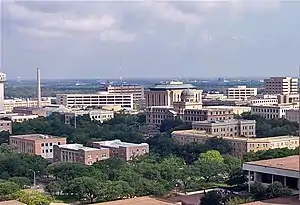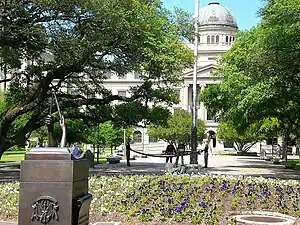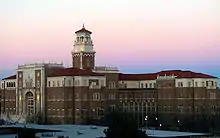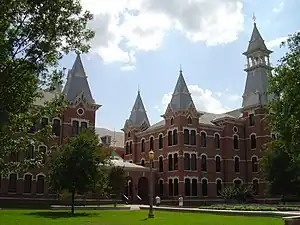Education in Texas
Texas has over 1,000 public school districts—all but one of the school districts in Texas are independent, separate from any form of municipal or county government. School districts may (and often do) cross city and county boundaries. Independent school districts have the power to tax their residents and to assert eminent domain over privately owned property. The Texas Education Agency (TEA) oversees these districts, providing supplemental funding, but its jurisdiction is limited mostly to intervening in poorly performing districts.
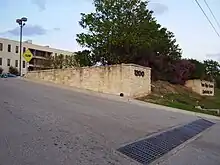
| This article is part of a series on |
| Education in the United States |
|---|
| Summary |
|
| Issues |
| Levels of education |
|
|
|
36 separate and distinct public universities exist in Texas, of which 32 belong to one of the six state university systems. The Carnegie Foundation classifies 11 of Texas's universities as research universities with very high research activity (Tier One status): Rice University, The University of Texas at Austin, Texas Tech University, University of Houston, University of North Texas, Texas A&M University, University of Texas at Dallas, University of Texas at El Paso, University of Texas at Arlington, Baylor University, and University of Texas at San Antonio.[1][2][3][4][5][6]
Primary and secondary education


Texas has over 1,000 school districts—ranging in size from the gigantic Houston Independent School District to the Divide Independent School District in rural south Texas, which has had as few as eight students at one time in the district. All but one of the school districts in Texas are separate from any form of municipal government, hence they are called "independent school districts", or "ISD" for short. School districts may (and often do) cross city and county boundaries. School districts have the power to tax their residents and to use eminent domain. The sole exception to this rule is Stafford Municipal School District, which serves all of the city of Stafford.[7]
The Texas Education Agency (TEA) has oversight of the public school systems as well as the charter schools. Because of the independent nature of the school districts the TEA's actual jurisdiction is limited. The TEA is divided into twenty Educational Service Center "regions" that serve the local school districts. The Robin Hood plan is a controversial tax redistribution system that provides court-mandated equitable school financing for all school districts in the state. Property tax revenue from property-wealthy school districts is distributed to those in property-poor districts, in an effort to equalize the financing of all districts throughout Texas.
Especially in the metropolitan areas, Texas also has numerous private schools of all types (non-sectarian, Catholic, and Protestant). The TEA has no authority over private school operations; private schools may or may not be accredited, and achievement tests are not required for private school graduating seniors. Many private schools will obtain accreditation and perform achievement tests as a means of encouraging future parents that the school is genuinely interested in educational performance.
It is generally considered to be among the least restrictive states in which to home school. Neither the TEA nor the local school district has authority to regulate home school activities; state law only requires that the curriculum 1 must teach "reading, spelling, grammar, mathematics and a study of good citizenship" (the latter interpreted to mean a course in civics) and 2) must be taught in a bona fide manner.[8] There are no minimum number of days in a year, or hours in a day, that must be met, and achievement tests are not required for home school graduating seniors. The validity of home schooling was challenged in Texas, but a landmark case, Leeper v. Arlington ISD, ruled that home schooling was legal and that the state had little or no authority to regulate the practice.
As of 2010 49% of children enrolled in public Pre-K through 12 primary and secondary schools in Texas are classified as Hispanic.[9] In the decade from the 1999-2000 school year to the 2009–2010 school year, Hispanics made up 91% of the growth in the state's public K-12 schools. The overall student body increased by 856,061 students, with 775,075 of those students being Hispanic.[10]
Although unusual in the West, school corporal punishment is not uncommon in more conservative areas of the state, with 28,569 public school students[11] paddled in Texas at least one time during the 2011–2012 school year, according to government data.[12] The rate of school corporal punishment in Texas is surpassed only by Mississippi, Alabama, and Arkansas.[12]
Textbooks and curriculum
The state curriculum in Texas is specified in the Texas Essential Knowledge and Skills (TEKS), which are updated and maintained Texas State Board of Education (SBOE).[13] The state has never adopted the Common Core State Standards Initiative.[14] The State Board of Education also selects the textbooks that are used in public schools;[15] many other states also use textbooks developed in Texas.[16]
Bias and accuracy
Social studies textbooks and curricula in Texas have often been criticized for having a conservative Christian bias and lack of factual accuracy with regards to history and religions,[17] and for portraying Islam and conflicts in the Middle East in a negative manner.[18] Notably, the curriculum for American history teaches that Moses was an important influence on the Founding Fathers.[17] A 2014 report by the Texas Freedom Network also found, among other issues, that the then-proposed American history textbooks downplayed the role of conquest and slavery; gave an inadequate and unbalanced overview of LGBT people and Native Americans; and gave undue praise of laissez-faire capitalism.[19] SBOE panels who select textbooks are rarely teachers or academics,[19] and are chosen in elections with minimal turnout.[20]
In 2021, the state legislature passed Texas House Bill 3979, which bans the teaching of critical race theory.[21] The American Historical Association, among others, expressed concern that the bill's broad scope could lead to omission or whitewashing of controversial race or gender topics in social studies.[22] The Carroll Independent School District school board came under fire for claiming that books about the Holocaust would have to be balanced with ones "that [have] other perspectives" under the new law, though education experts and the district's superintendent disagree that the law will affect the factual accuracy of educational material.[21]
The science curriculum adopted in 2009 was the first to include a full overview of the theory of evolution, but faced backlash after the final version included a loophole that allowed schools to dismiss evolution in favor of creationism.[23] The current 2017 science curriculum in Texas does not mandate the teaching of evolution over creationism, but removed language that was perceived to have discouraged the teaching of evolution.[24][25]
Standardized tests
The State of Texas Assessments of Academic Readiness (STAAR) are a series of standardized tests used in Texas primary and secondary schools to assess students' attainment of reading, writing, math, science, and social studies skills required under Texas education standards. It is developed and scored by Pearson Educational Measurement with close supervision by the Texas Education Agency. Though created before the No Child Left Behind Act was passed, it complies with the law. It replaced the previous test, called the Texas Assessment of Knowledge and Skills, or TAKS test, in 2017.[26] The TAKS test replaced the Texas Assessment of Academic Skills, or TAAS test, in 2003.
Public colleges and universities
Texas' controversial alternative affirmative action plan, Texas House Bill 588, guarantees Texas students who graduated in the top 10 percent of their high school class automatic admission to state-funded universities. The bill encourages demographic diversity while avoiding problems stemming from the Hopwood v. Texas (1996) case.
Thirty-five (35) separate and distinct public universities exist in Texas, of which 33 belong to one of the six state university systems.[27][28] Discovery of minerals on Permanent University Fund land, particularly oil, has helped fund the rapid growth of the state's two largest university systems: The University of Texas System and the Texas A&M System. The four other university systems: the University of Houston System, the University of North Texas System, the Texas State System, and the Texas Tech System are not funded by the Permanent University Fund.
Both the University of Texas and Texas A&M University were established by the Texas Constitution and hold stakes in the Permanent University Fund. The state has been putting effort to expand the number of flagship universities by elevating some of its seven institutions designated as emerging research universities. The two that are expected to emerge first are the University of Houston and Texas Tech University, likely in that order according to discussions on the House floor of the 82nd Texas Legislature.[29]
University of Houston System
The University of Houston System has four separate and distinct institutions; each institution is a stand-alone university and confers its own degrees. Its flagship institution is the University of Houston, a research university.[1][2][3] The three other institutions in the System are stand-alone universities; they are not branch campuses of the University of Houston.
The flagship institution of the System, the University of Houston, ranks No. 189 in the National University Rankings of U.S. News & World Report, and No. 106 among top public universities.[30][31]
The University of Houston System's annual impact on the Texas economy equates to that of a major corporation: $1.1 billion in new funds attracted annually to Texas, $3.13 billion in total economic benefit, and 24,000 local jobs generated.[32][33] This is in addition to the 12,500 new graduates the UH System produces every year who enter the workforce throughout Texas.[33]
.JPG.webp) University of Houston
University of Houston UH–Clear Lake
UH–Clear Lake_Houston.jpg.webp) UH–Downtown
UH–Downtown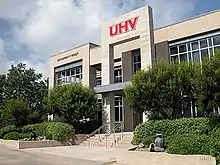 UH–Victoria
UH–Victoria
University of North Texas System
The University of North Texas System (UNT System) has three schools in the North Texas region, all of which are in the Dallas/Fort Worth Metroplex.
The flagship institution is the University of North Texas (UNT) located in Denton. UNT is the second largest university in the Metroplex and sixth largest in the state. The fields taught at UNT focus on such areas as business management, education, engineering, hospitality, music and science.
The UNT System also oversees the University of North Texas at Dallas, the only public university located in the city limits of Dallas, and the University of North Texas Health Science Center at Fort Worth, the only college in Texas that specializes in osteopathic medicine.
University of Texas System
The University of Texas System, established by the Texas Constitution in 1883, consists of eight academic universities and six health institutions, with a seventh health institution to be established and a ninth academic institution to be added in the near future. UT System institutions enrolled a total of 182,752 students in fall 2004 making it one of the largest systems of higher education in the nation. In 2018, the system's flagship and largest institution, University of Texas at Austin, maintained an enrollment of 51,832 students.[34] The University of Texas at Austin was once the largest institution in the United States, but it is now one of the top 10 largest by population. It is ranked as the 34th best global university by U.S. News & World Report.[35] Seven doctoral programs at UT Austin rank in the top 10 in the nation and 22 degree programs rank in the top 25, according to a comprehensive study of the quality of graduate schools conducted by the United States National Research Council. Six of the 12 medical schools of Texas are within the University of Texas System. In 2004, the University of Texas Southwestern Medical Center at Dallas was ranked the 12th highest ranking medical school in the United States, with four of Texas's 11 Nobel laureates.[36]
Stephen F. Austin State University in Nacogdoches, which operates one of two schools of forestry and the only one in the state's main timber-producing region of East Texas, joined the University of Texas System in 2023.
Texas A&M University System
The Texas A&M University System, established by the 1871 Texas legislature, is the largest state university system of higher learning in Texas. Its flagship institution, Texas A&M University located in College Station, opened in 1876, is the state's oldest public institution of higher education, and, at over 62,000 students, has the largest student enrollment in the state of Texas.[37] As opposed to the University of Texas System, which is primarily focused in urban centers, the Texas A&M System generally serves rural areas of the state.
Prairie View A&M University is a historically black university located in Prairie View, Texas (northwest of Houston) and is a member of the Texas A&M University System. PVAMU offers baccalaureate degrees in 50 academic majors, 37 master's degrees and four doctoral degree programs through nine colleges and schools. Founded in 1876, Prairie View A&M University is the second oldest state-sponsored institution of higher education in Texas.
Texas State University System
The Texas State University System, created in 1911 to oversee the state's normal schools (teachers' colleges), is the oldest multi-system University System in Texas.[38] The system is the only one of the six Texas state university systems to be a horizontal system: it does not have a flagship institution and considers every campus to be unique in its own way.[39] Over the years, several member schools have been moved to other university systems. Today, the system encompasses seven institutions; Texas State University, located halfway between Austin and San Antonio in San Marcos, Texas, is the largest university in the system with an enrollment of 38,694 students.[40] Lamar University located in Beaumont, Texas and previously in its own system, joined the TSUS in 1995.[41] It boast an enrollment of 14,384 students as of spring 2010 and is most notable for its highly respected engineering program.[42] Sam Houston State University located in Huntsville, Texas is the 2nd largest university in the TSUS with 18,478 students and is home to one of the world's largest and best Criminal Justice Programs.
Texas Tech University System
The Texas Tech University System was established in 1996, though the system's oldest institution, was founded in 1923. The system comprises four separate universities, of which two are academic institutions: Angelo State University and Texas Tech University, and two are health institutions: Texas Tech University Health Sciences Center, and Texas Tech University Health Sciences Center at El Paso.
Texas Tech University, founded as Texas Technological College in 1923, is the system's flagship institution located in Lubbock. The institution originally comprised only four schools: Agriculture, Engineering, Home Economics, and Liberal Arts. Today, the university includes eleven academic colleges, a graduate school and a school of law. The campus in Lubbock is shared with the Texas Tech University Health Sciences Center.
In 1969, a separate university named the Texas Tech University School of Medicine (now Texas Tech University Health Sciences Center (TTUHSC)), was founded as a multi-campus institution with Lubbock as the administrative center and with regional campuses at Amarillo, El Paso, and Odessa. The university was expanded to include nursing, pharmacy, and allied health sciences programs in 1979. The university has expanded to include campuses in Abilene, and Dallas.
In 2007, Angelo State University joined the Texas Tech University System leaving the Texas State University System, which it had been a member of since 1975.
On May 18, 2013, the former branch campus of TTUHSC in El Paso was established as the Texas Tech University Health Sciences Center at El Paso (TTUHSC El Paso) a separate university from TTUHSC with schools of medicine and nursing.
On August 6, 2020, the Texas Tech University System and Midwestern State University agreed to a memorandum of understanding to begin the process of MSU Texas becoming the fifth university to join the system. The process was completed on June 8, 2021, when Governor Greg Abbott signed HB 1522 into law.
Texas Woman's University System
On May 26, 2021, Texas Woman's University was established as the Texas Woman's University system according to a bill signed into law by Governor Greg Abbott[43] This law headquarters the system in Denton and allows the former Dallas and Houston Centers to become autonomous campuses.
Independent universities
- Texas Southern University in Houston is unaffiliated with any of the seven systems. Texas Southern is the only historically black university in Texas to house a law and pharmacy school and one of only two public historically black universities in the state. Texas Southern was also the first state-supported institution in the city of Houston.
Texas State Technical College System
The state also operates the Texas State Technical College System, a group of two-year technical colleges located throughout the state. System headquarters are co-located with the flagship campus in Waco.
Community colleges
Several community colleges operate throughout the state of Texas. Although the state has established territorial jurisdictions for each college, the colleges themselves are governed by local boards of trustees, and are financed mainly through local property taxes.
The taxing area and the jurisdiction are not necessarily the same in all cases. As an example, the jurisdiction of North Central Texas College includes the counties of Cooke, Denton, and Montague, but only Cooke County property is subject to the property tax assessment. On the other hand, the jurisdiction and tax base for Tarrant County College are the same: Tarrant County.
Private colleges and universities
Austin area
Institutions of higher education include Austin Presbyterian Theological Seminary, Concordia University Texas, Huston–Tillotson University, St. Edward's University, the Seminary of the Southwest, the Acton School of Business, Austin Graduate School of Theology, Austin Presbyterian Theological Seminary, Virginia College's Austin Campus, The Art Institute of Austin, and a branch of Park University.
Central Texas (excluding Austin)
Baylor University, chartered in 1845 by the Republic of Texas, is the oldest university in Texas operating under its original charter. Baylor University purports to be the largest Baptist university in the world, having an enrollment of over 14,000 students. Baylor is accredited by the Southern Association of Colleges and Schools and is a member of the Association of Southern Baptist Colleges and Schools. The 735-acre (2.97 km2) campus is located just southeast of downtown Waco, roughly bounded by Interstate 35, Speight Avenue, Eighth Street and the Brazos River.
Texas Christian University (TCU) is a private university located in Fort Worth, Texas. The school is accredited to award baccalaureate, masters, and doctoral degrees.
Howard Payne University is a Christian university in Brownwood, Texas.
Hardin-Simmons University, McMurry University, and Abilene Christian University are Christian universities in Abilene, Texas.
The University of Mary Hardin–Baylor is a Christian university in Belton, Texas.
Southwestern University is a private university in Georgetown, Texas. Southwestern is the oldest university that was established on Texas land, but it was founded as several different universities from 1840 - 1865 and did not become Southwestern University until 1873, when the charters of these universities were revitalized and merged into one university.
Dallas–Fort Worth area
The Dallas–Fort Worth metroplex is home to several private universities such as Southern Methodist University (which has the Metroplex's largest law school), University of Dallas, Texas Wesleyan University, Texas Christian University, Dallas Baptist University, and Paul Quinn College. Dallas' sole public university is the University of North Texas at Dallas.
Austin College
Austin College is a private liberal arts college affiliated with the Presbyterian Church USA and located in Sherman, Texas, an hour north of Dallas. Chartered in November 1849, it is the oldest college in Texas under original charter and name as recognized by the State Historical Survey Committee. The school is named after Texas hero Stephen F. Austin, who along with his sister Emily, deeded 1,500 acres (6 km2) of land to the college. Another important figure in Texas history, Sam Houston, served on the original board of trustees for the school. U.S. News & World Report ranked Austin College among the top 100 colleges in the category of "Best Liberal Arts Colleges" for 2006. Austin College also ranked among the "Best 361 Colleges" in the 2006 Princeton Review, was profiled in Loren Pope's Colleges That Change Lives, and was profiled in the 2005 edition of Kaplan's Unbiased Guide to the 331 Most Interesting Colleges. Austin College is also ninth on the U.S. News' 2006 list for "most students studying abroad." It is a member of the International 50, a group of the top colleges in the nation for international focus.
Houston area
Houston is the location of Rice University, which boasts a substantial financial endowment. The small undergraduate student body has one of the highest percentages of National Merit Scholarship winners in the United States. Rice University maintains a variety of research facilities and laboratories.
The University of St. Thomas is a liberal arts college in Houston. It was founded by the Basilian Order in 1947 as a Roman Catholic university. Former UST President Archbishop J. Michael Miller currently serves in the Roman Curia as the prefect of Catholic universities throughout the world. The campus is also home to some major historic buildings, such as the Link-Lee Mansion (once the largest house in Texas) and Hughes House (the childhood home of Howard Hughes).
Houston Christian University is a Baptist university founded in 1960 that enrolls approximately 3,500 students.
Panhandle Area
Lubbock Christian University is a Christian university in Lubbock, Texas.
Wayland Baptist University is a private university affiliated with the Baptist church and is located in Plainview, Texas. In addition to the main campus in Plainview, Wayland maintains campuses in Amarillo, Lubbock, San Antonio, and Wichita Falls in Texas, It also maintains campuses out of Texas in Albuquerque, NM; Altus, OK; Anchorage, AK; Clovis, NM; Fairbanks, AK; Mililani, HI; Phoenix, AZ; and Sierra Vista, AZ. Several of the campuses have satellite locations in other cities in their area and on many of the military bases nearby. The university also offers courses in American Samoa, Kenya, and on-line. In 2016, Wayland began offering their first doctorate program, a Doctor of Management degree.[44]
San Antonio area
Private universities in the area are Trinity University, St. Mary's University, University of the Incarnate Word, Texas Lutheran University, and Our Lady of the Lake University.
Presidential Libraries
Universities in Texas currently host three presidential libraries: the Lyndon Baines Johnson Library and Museum at The University of Texas at Austin, the George Bush Presidential Library at Texas A&M University, and the George W. Bush Presidential Center at Southern Methodist University.
Medical research

Texas is home to several research medical centers. The state has 12 allopathic medical schools,[45] three osteopathic medical schools, four dental schools, and two optometry schools.[46] Texas has two Biosafety Level 4 (BSL-4) laboratories: one at The University of Texas Medical Branch (UTMB) in Galveston,[47] and the other at the Southwest Foundation for Biomedical Research in San Antonio—the first privately owned BSL-4 lab in the United States.[48]
The Texas Medical Center, in Houston, is the world's largest concentration of research and healthcare institutions, with 45 member institutions in the Texas Medical Center.[49] More heart transplants are performed at Texas Medical Center than anywhere else in the world.[50] San Antonio's South Texas Medical Center facilities rank sixth in clinical medicine research impact in the United States.[51] The University of Texas M. D. Anderson Cancer Center is one of the world's highly regarded academic institutions devoted to cancer patient care, research, education and prevention.[52]
Texas Digital Library
The Texas Digital Library is a consortium of institutions of higher education in the state of Texas.[53] The consortium provides an infrastructure for scholarly activity of its members.[54] Support currently includes an Electronic Theses and Dissertations system and Institutional Repository support.[55]
References
- Bonnin, Richard. "Carnegie Foundation Gives University of Houston its Highest Classification for Research Success, Elevating UH to Tier One Status". University of Houston. Retrieved 2011-02-08.
- "UH achieves Tier One status in research". Houston Business Journal. 2011-01-21. Retrieved 2011-07-06.
- "UH takes big step up to Tier One status". Houston Chronicle. 18 January 2011. Retrieved 2011-07-06.
- Tribune, The Texas (2 February 2016). "Four Texas Colleges Reach Carnegie "Tier One" Status". texastribune.org.
- Santana, Steven (2021-12-16). "UTSA becomes the first San Antonio university to earn prestigious ranking". mySA. Retrieved 2021-12-16.
- "Baylor University Earns Prestigious Research 1 Status from Carnegie Classification of Institutions of Higher Education". Media and Public Relations | Baylor University. 2021-12-16. Retrieved 2021-12-17.
- "Comptroller Strayhorn to Review Stafford Municipal School District" (Press release). Texas Comptroller Carole Keeton Strayhorn. 2003-09-16. Archived from the original on 2004-02-22. Retrieved 2008-06-28.
- "Texas Home School Coalition FAQ". Archived from the original on 2006-04-24. Retrieved 2006-04-29.
- Scharrer, Gary. "In schools, a peek at Texas' future." Houston Chronicle. May 16, 2010. Retrieved on May 17, 2010.
- Scharrer, Gary. "Hispanic children make up 91% of school enrollment growth." San Antonio Express-Tribune. June 2, 2010. Retrieved on November 6, 2011.
- Please note this figure refers to only the number of students paddled, regardless of whether a student was spanked multiple times in a year, and does not refer to the number of instances of corporal punishment, which would be substantially higher.
- Farrell, Colin (February 2016). "Corporal punishment in US schools". World Corporal Punishment Research. Retrieved April 4, 2016.
- Agency, Texas Education (2019-10-01). "Curriculum Standards". Texas Education Agency. Retrieved 22 May 2021.
- AL.com: Unlike Alabama, these five states didn't adopt the Common Core. November 12, 2013.
- Agency, Texas Education (2021-05-11). "Instructional Materials". Texas Education Egency. Retrieved 22 May 2021.
- Jervis, Rick (17 November 2014). "Controversial Texas textbooks headed to classrooms". USA TODAY. Retrieved 22 May 2021.
- Klein, Rebecca (2014-10-22). "These Biased Ideas Are Presented As Fact In Texas Curriculum Standards". HuffPost. Retrieved 22 May 2021.
- "'I Felt Like They Were Demonizing My People': Advocates and Families Point to Biases in Texas Curricula". The Texas Observer. 2021-04-29. Retrieved 22 May 2021.
- "Proposed Texas textbooks are inaccurate, biased and politicized, new report finds". The Washington Post. 12 September 2014. Retrieved 22 May 2021.
- Collins, Gail (21 June 2012). "How Texas Inflicts Bad Textbooks on Us | by Gail Collins | The New York Review of Books". New York Review Books. Retrieved 22 May 2021.
- Lopez, Brian (October 16, 2021). "The law that prompted a school administrator to call for an "opposing" perspective on the Holocaust is causing confusion across Texas". The Texas Tribune. Retrieved October 17, 2021.
- "AHA Issues Letter Objecting to Texas Bill". American Historical Association. May 19, 2021. Retrieved July 26, 2021.
- Kopplin, Zack (2013-09-20). "Showdown Over Science in Texas". Slate Magazine. Retrieved 22 May 2021.
- Kopplin, Zack (2013-09-20). "Showdown Over Science in Texas". Slate Magazine. Retrieved 22 May 2021.
- Simmons, Monica. "Texas School Board Approves New "Evolution" Language". San Antonio Current. Retrieved 22 May 2021.
- "TAKS". Texas Education Agency. Texas Education Agency. Retrieved 15 October 2022.
- Heath, Ben (July 7, 2003). "Bill requires review of university systems" (PDF). Daily Texan. Archived from the original (PDF) on February 5, 2009. Retrieved October 12, 2007.
- "Senate Subcommittee on Higher Education Testimony Regarding the Benefits of a Stand Alone Institution" (PDF). Sam Houston State University. June 25, 2008. Archived from the original (PDF) on October 28, 2008. Retrieved October 12, 2008.
- "Tier-One Prize Money Tentatively Passes House". 14 April 2011. Retrieved April 27, 2011.
- "National University Rankings". U.S. News & World Report. Retrieved September 15, 2012.
- "Top Public Schools: National Universities". U.S. News & World Report. Retrieved September 15, 2012.
- TRESAUGUE, Matthew (2006-05-17). "Study suggests UH degrees are crucial economic factor". Houston Chronicle. Retrieved 2011-05-31.
- "The Economic Impact of Higher Education on Houston: A Case Study of the University of Houston System" (PDF). University of Houston System. Archived from the original (PDF) on 2011-07-20. Retrieved 2011-05-14.
- "Facts & Figures | The University of Texas at Austin". www.utexas.edu. Retrieved 2020-02-22.
- "Best Global Universities". U.S. News & World Report. Retrieved February 21, 2020.
- The Academy of Medicine, Engineering and Science of Texas Archived 2005-12-17 at the Wayback Machine list of Texas Nobel Laureates
- "Texas A&M University Enrollment Profile: Fall 2014" (PDF). Texas A&M University. pp. i. Retrieved October 25, 2014.
- "Texas State University System". Retrieved November 9, 2009.
- "SHSU graduate appointed System Regent". Huntsville Item. Archived from the original on January 26, 2013. Retrieved November 5, 2009.
- Blaschke, Jayme (April 23, 2018). "Texas State sets new enrollment record of 30,816". Office of Media Relations. Retrieved August 23, 2018.
- "College News". Lamar.edu.
- "College News". Lamar.edu.
- "Bill establishing TWU System becomes law - Texas Woman's University".
- "Home". wbu.edu.
- "Texas Medical Schools and Hospitals". Texas Medical Association. 2006-08-03. Retrieved 2008-04-28.
- "TEXAS OPTOMETRY BOARD: Information". Archived from the original on 2011-08-18. Retrieved 2011-04-07.
- "University Selects Bioscrypt for Biosafety Level 4 Lab". Bioscrypt. October 14, 2004. Archived from the original on 2006-03-14. Retrieved 2006-04-29.
- "BIOSAFETY LEVEL 4 (BSL-4) LABORATORY". Southwest Foundation for Biomedical Research. Archived from the original on 2007-06-29. Retrieved 2006-04-29.
- Facts and Figures Archived 2007-06-24 at the Wayback Machine. Texas Medical Center. 2006. Last Retrieved 2007-03-17.
- "Background Statistics > People and Politics (most recent) by state". State Master. 2008-05-08. Retrieved 2008-05-08.
- "Health Science Center ranks sixth in clinical medicine". XL (7 ed.). University of Texas Health Science Center. 2007-04-03. Retrieved 2008-04-28.
{{cite journal}}: Cite journal requires|journal=(help) - "About MD Anderson". The University of Texas M. D. Anderson Cancer Center. Archived from the original on 2008-04-24. Retrieved 2008-04-28.
- "Introducing Vireo: an ETD Submittal and Management System for DSpace" (PDF).
- "Building the Texas Digital Library". Archived from the original on 2012-02-19. Retrieved 2014-03-08.
- "University of Houston Library Resources - Texas Digital Library Description".

